INTRODUCTION
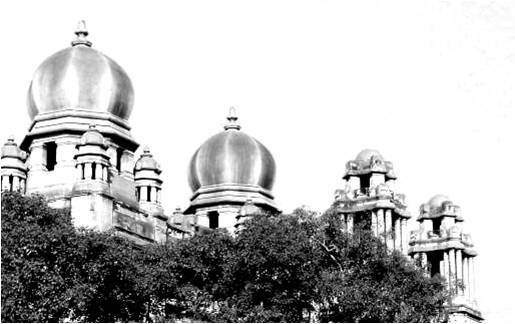
- linear in plan with apsidal ends, this majestic single floor high structure rests on a high plinth, whose striking outward slope adds to its imposing appearance.
- equally tall chamfered, bay windows that run from floor to ceiling line the sides of the central hall that house the stacks.
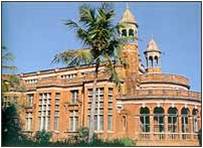
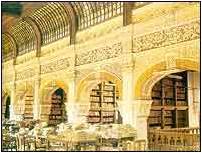
- small square panels of stained glass windows are offset by numerous decorative friezes and pilasters, all of terracotta, that blends with the fine exposed brick walls.
- while the four corners of the building are articulated by light airy towers crowned by cupolas, the ends are punctuated by dutch gables .
- the interior of this indo-saracenic masterpiece is even more stunning. crowned by a large mangalore tile roof, the end layers are fitted with glass tiles to allow for natural light.
- softened by a false ceiling of stained glass in the shape of a vault, this light lends a magical glow to the interior and is rejected further by highly embellished walls of relief plaster.
- the stone flooring of the hall is recorded to have come from the krishna district in andhra pradesh.
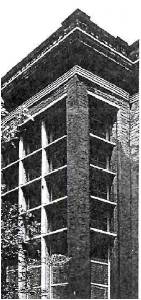
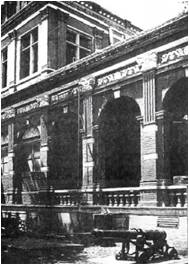
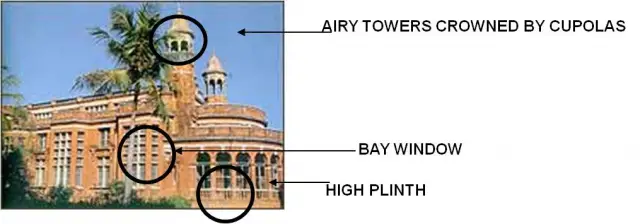
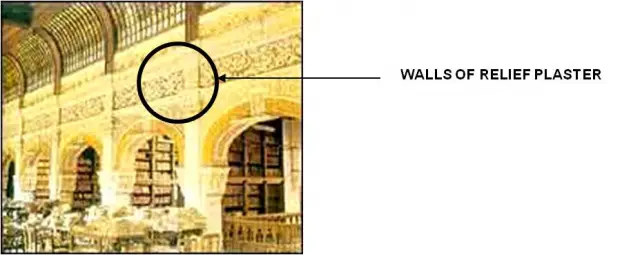
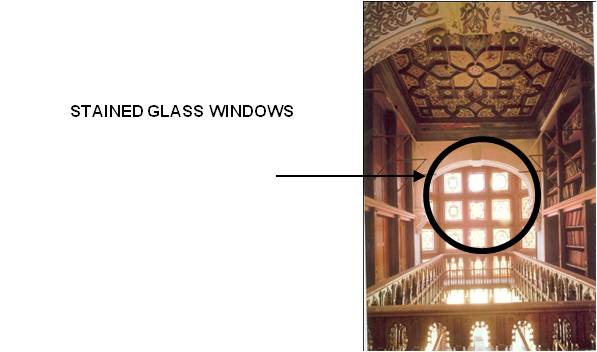
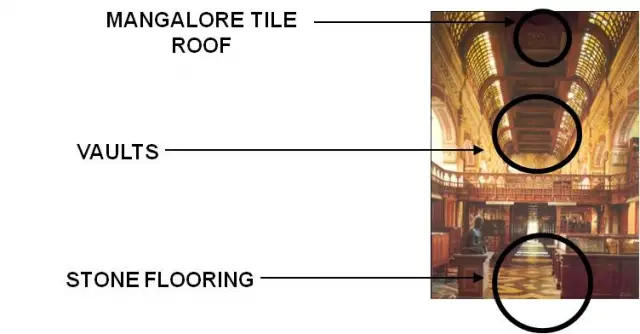
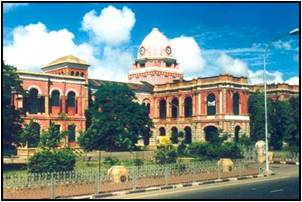
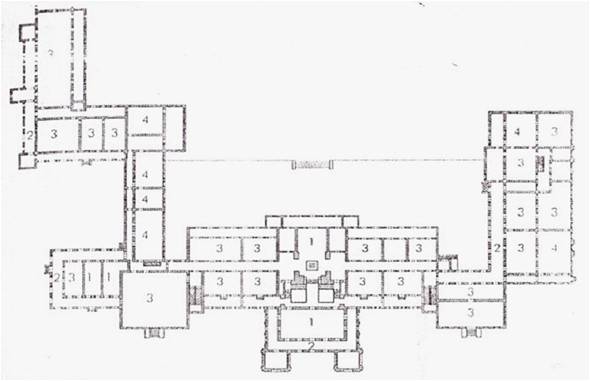
- offices
- arcades
- classrooms
- labs
- unlike later colonial buildings that were largely brick compositions. the college is a collage of rusticated grey granite stone facing, exposed brick, and a variety of finishes such as pink sand stone and black gneiss columns and arches.its design was a resyult of an open competition. one of the first buildings by robert chisholm, who bagged the honours, the college’s italian style, though unique, is extremely foreign in composition and detail.
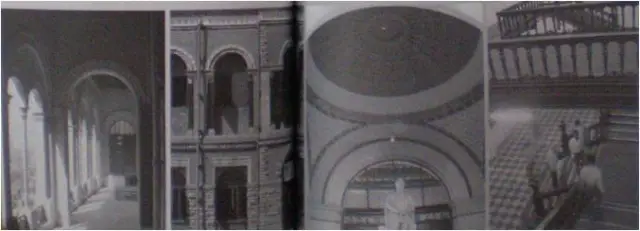 ARCHES MOTIFS CUPOLAS STAIRCASE
ARCHES MOTIFS CUPOLAS STAIRCASE
- its most attractive features is a central hall with a majestic staircase flanked by class rooms on either side of wide central corridor.
- the staircase at the ends are expressed as low rectangular towers topped by a hip roof, with plaster articulation on the exterior in imitation of roman pantiles.
SENATE HOUSE :R. F. CHISHOLM
The senate house, with in the madras university campus, is british architect robert fellowes chisholm at his very best. the design of this building were choosen through an open competition announced by the madras government in 1864. completed by 1879 at a cost of rs 289,000, the senate house was to serve as the examination hall and offices of the madras university.
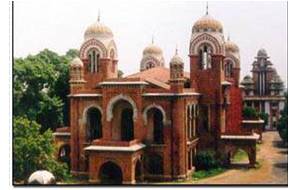
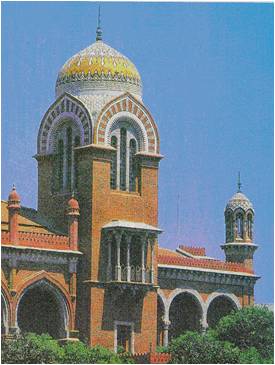
- inspired by the byzantine and built in the indo-saracenic style, the senate house ia the ultimate manifestation of this style.
- it comprises of large two floor high central hall, 16m high, measuring approx. 50m by 15m, and has a capacity to seet 1600 people.
- though laid out as a simple rectangle, a strong variation in form is achieved on the sensitive lacing of the four towers on simple square projections that fall behind each of the side entrance porches.
- these towers are covered by pendentive bulbose domes that are highly articulated with intricate surface decoration.
- arches and domes are covered with flowing geometric patterns.
- tinier cupolas on octogonal drums pin the corners with a series of turrets lining the east and west sides.
- the walls too are myraid of details and a truly fine composition of light and shade.
- impressive double floor high verandas on the east and west faces are lined by stone columns with sculptured capitals bearing human figures and hindu icons and support large horseshoe arches trimmed in stone..
- the wall of the verandah facing the hall is broken by giant doors with large clearstorey circular openings decorated by ornate geometrical patterns of coloured glass.
- the result is afinely proportioned mass with a high fenistrated lower portion, terminated by vertical solid masses that soar skywards.
SENATE HOUSE
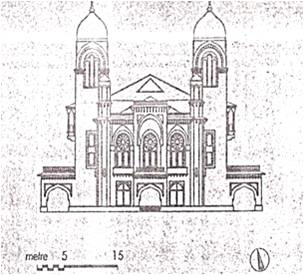
South Elevation
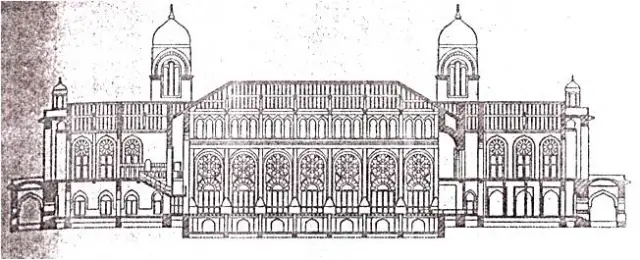
Longitudinal Section
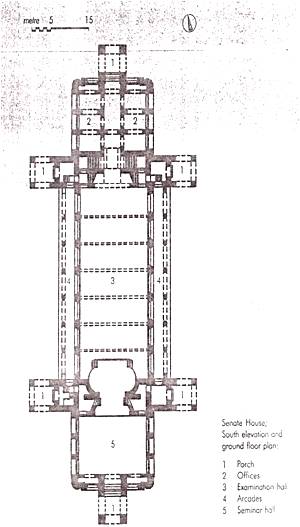
- porch
- offices
- arcades
- exam hall
- seminar
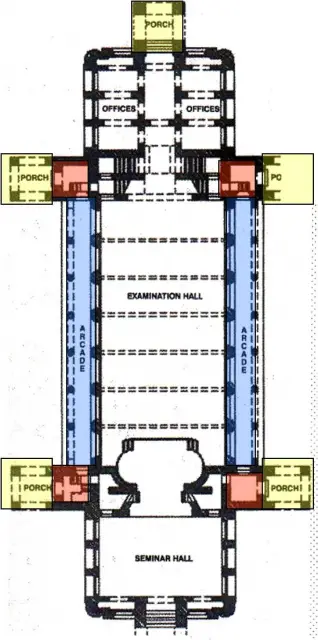
![]() tower
tower
![]() porch
porch
![]() double height verandah
double height verandah
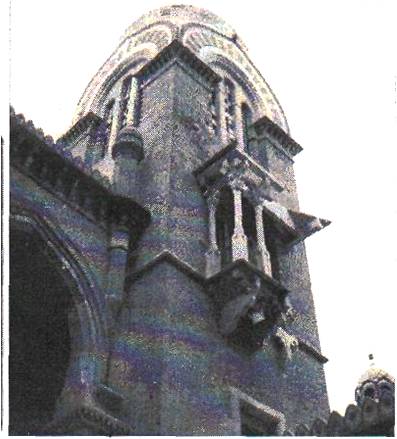
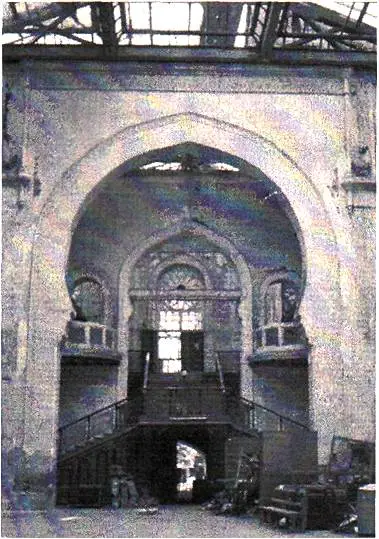
Entrance
VICTORIA PUBLIC HALL
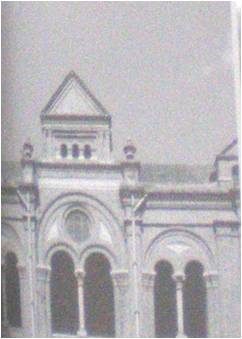
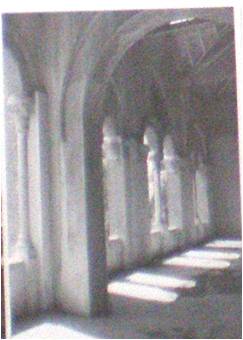
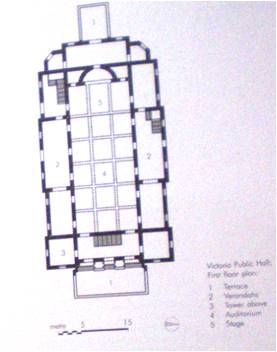
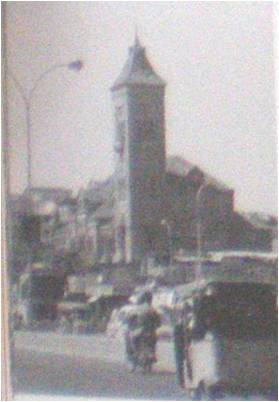
- the victoria public hall, often also known as the town hall was built in 1887 to honour queen victoria on her golden jubilee.it was built on a land donated by maharajah of vizianagaram. the main functions of the building being stage performances , lectures and as a ballroom.
- designed in the romanesque style and rectangular in the plan (measuring approx. 46m x 26m)
- the special features include arcaded verandahs along the northern and southern sides supported on sleek corinthian columns and a tall square tower that rises at least three floors above the rest , covered by a pyramidal roof typical of many other buildings of this period.
- the main construction material being red brick and painted with lime mortar, the intermediate floor is of madras terrace while the roof is a large hip with mangalore tiles and the dormers at the end along it’s length
- the walls of the top floor are highly embelished with the decorative and painted plasterwork on the interior and the gallery constructed entirely in wood.an intricately carved terracotta frieze resembeling islamic calligraphy adorns the top of the tower.
- as in the other buildings of it’s similar style and form, the town hall too appears to be more human in scale and stature ,mostly due to it’s brickwork,sleek and slender details and the large tiled roof.
THE CHEPAUK PALACE :R.F.CHISHOLM.
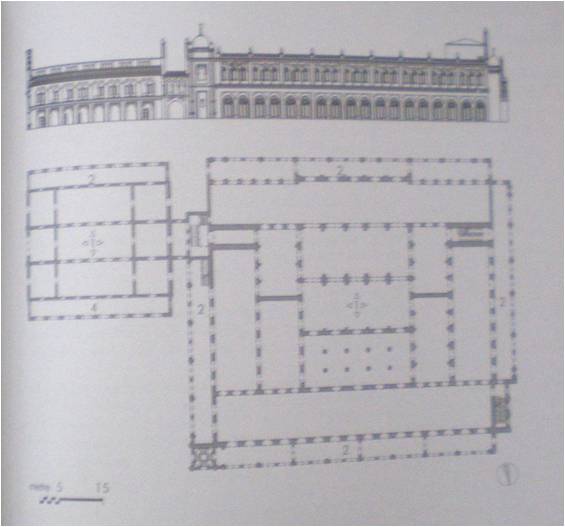
- thechepauk palace is one of the oldest buildings on marina.located at the junction of south beach road or kamarajar sarai and wallaja road just across the senate house it now houses various governement deptt.
- the palace was constructed by wallajah muhammad ali,the nawab of carnatic for moving his residence from the town of arcot to the palace.
- the main architect of the building was paul benfield. later on numerous additions were made by the govt. in this building.which were done by r.f.chisholm.
- the building comprises of two blocks : humayun mahal and the khalsa mahal
- the majority of additions were done to the humayun mahal while the khalsa mahal was largely left as it was.the humayun mahal was transformed into the revenue board building in 1871 while the khalsa mahal incorporated the engineering college and the office of the pwd.
HUMAYUN MAHAL
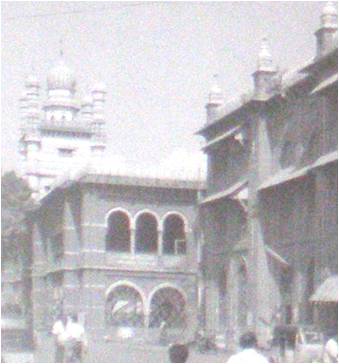
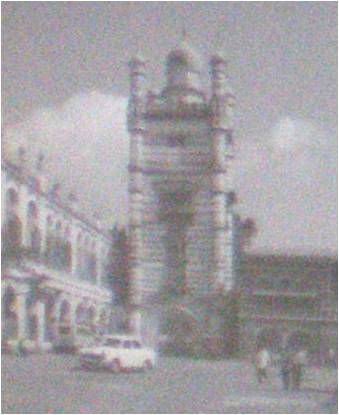
- it was originally a single storeyed structure with the often cited,two flor high durbar hall
- rooms were added later on the south and east faces of the mahal. they were designed by r chisholm to match with the original building style but also with purer indo-sarcenic details.these additions were filled with horseshoe arches,stone and cast iron columns. a porch was placed in front of the triple dome entry on the west.
- the separate entry building added to the east of the mahal is linked to the main structure by a carriageway.the enterance of this building being on the east ,reoriented the entire palace towards the new road along the sea and away from the main enterance on the enterance on the west.this squarish two storeyed structure with an impressive two-floor high arched gateway and projecting intricately worked wooden balcony created a new focal point for the whole palace
GENERAL POST OFFICE :Robert Fellowes Chisholm.
The general post office on the north beach road is today known as the rajaji salai. it has been described as one of the major historic structures on the beach road which lend a character to it. it was designed and completed in 1884 by robert fellowes chisholm.
It has been laid out as a rectangle measuring about 100m x 50m. with a floor area of over 5000 sq.m.
- a courtyard in the east-west direction bifurcates the building.
- the main postal hall is located on the southern face of the building. it has a height of about 13 m and measures 30m x 15m.
- flight of steps on the porch lead to the upper storey of the building.
- the building is mostly brick which has been painted on the exterior in red and the interior has been plastered white.
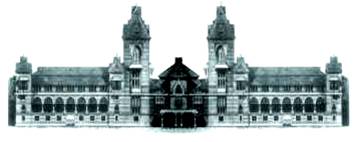
- the building has hindu designs in most of its embellishments.
- the roofs in the buildings are varied. there is the flat roof and the gable roof with dormer windows.
- there are also towers of varying heights intercepting the gables. they have balconies appended
- the projecting eaves are supported by stone brackets and this seems to be a hindu influence.
- the arches in the veranda and the exterior are pure saracen. however, arches in the interior of the building show gothic influence.
- . its pillars are of corinthian order and has square flat topped towers.
- the gabled ventilators on the roof besides a chimney and some of the fenestrations reflect a victorian “country-colonial” .
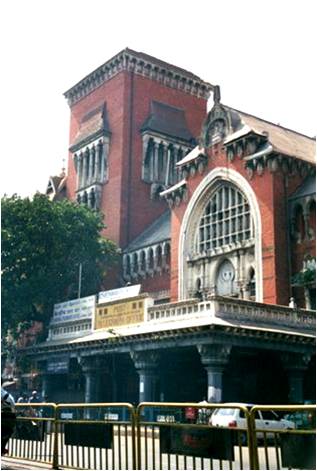
Corinthian pillars and Red Brick on the exterior
- the arches, columns, and all other details are cut in stone. the arches which occupy the longer faces of the building have on them intricate jali work carved in stone.
- the roofs may have been inspired by the timber roofs in kerala, also seen in another design by r.f. chisholm in travancore – the napier museum.
- after a fire in the buildings many parts of the edifice were damaged and restoration of the place has not materialized till now. the damaged roofs, which were lost to a cyclone, have not been replaced.
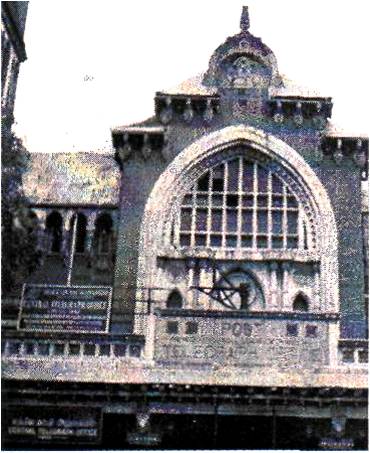
Hindu Stone Brackets and Saracen Arcb
ARCHITECTURAL EXPRESSION
The indo-saracenic architecture employed several styles of architecture on one particular building.
- brackets, cornices, domes, chhatris and finials and various surface ornamentations were applied.
- in certain cases hindu iconography was also used.
- decorative parapets which incorporated lotus motifs and also the cusped arch could be seen.
- in many buildings the forms were attenuated and the facades were given a greater spatial variety and depth.
Mixing and matching several styles, gave the architects more opportunities to be creative and nobody to confront. they felt no compulsion to stick to a style of architecture and created hybrid designs.
EFFECT ON PLANNING
The colonial influence, resulted in a synthesis and confluence of styles, the repercussions of which gave new dimensions to the planning of the buildings.
- the size of the rooms substantially increased. the indian proportions of the rooms were much smaller than their european counterparts.
- concepts of dining rooms, ballrooms, tennis courts and other such activities are a colonial influence. the palaces were no longer restricted to the fortified palaces; they had become english country houses with an indian veneer.
- the buildings show spatial separation, such as gates, barriers, a symmetrical axis of approach and height and size as expressions of power. even the interior of the buildings were based on european designs and upholstery.
- the planning takes into account the climate of the place and concessions have been made in the design to suit it. the walls have been made thick. almost all the buildings have a veranda.
CONCLUSION
- it was an idea which brought a balance between being an imperial power, and building with context to only the place it was built in. but the architecture still remained foreign and could not blend in with the indian architecture.
- also the indian entablatures were based on a system of geometry and proportions. they were based on the proportions of internal planning of the buildings. indo-saracenic, however, employed the same indian details onto a design based on different proportions. the details which were to be slender are now robust.
- so the style is indeed a mixture of indian and islamic architecture but it remained basically british in sitting, spatial organization and composition. it did evolve over time and the degree of complexity in the homogeneity of the design increased in the manner of their borrowing from the indian prototypes. the eccentricity in the buildings makes them interesting as well as hard to interpret as a style.
- but, the architectural expression of the indo-saracenic is different from other hybrid styles, as it was a conscious attempt by the british to show a sense of belonging to the country.

Leave a Reply
You must be logged in to post a comment.